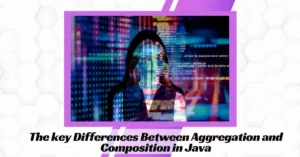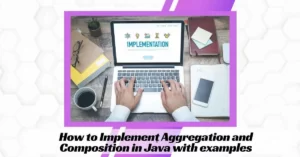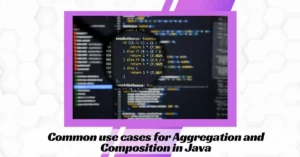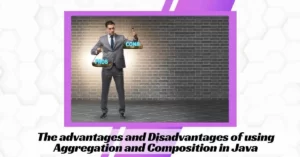Table of Contents
ToggleIntroduction
Aggregation and Composition in Java are two key concepts in object-oriented programming (OOP) that determine the way objects interact with one another. These relationships are essential for allowing objects to collaborate to achieve more complex tasks.
Aggregation is a type of relationship between two objects where the parent object contains a reference to the child object as part of its state. This means that an object can be seen as an aggregate of other objects, if it holds references to them. This concept is often represented graphically in UML diagrams by a diamond-shaped arrowhead pointing from the containing object towards the contained object. Aggregation is a special form of association, which allows one class to use or access members of another class in order to perform specific tasks.
Composition is a type of relationship between two objects, where one object is composed of the other. This means that the containing object owns the contained object and is responsible for its creation and destruction. This type of relationship is typically represented in UML diagrams by an arrowhead with a filled diamond at the end, pointing from the containing object to the contained object.
The major difference between Aggregation and Composition lies in the lifecycle of the contained object. Aggregation and Composition in Java, In Aggregation, the contained object can still exist independently from its containing object – whereas in Composition, if something happens to the containing object, it will affect the contained object as well. In short, while both relationships present a form of connection between objects, they have different implications when it comes to ownership and responsibility.
In Java, Aggregation and Composition can be implemented using instance variables to hold references to other objects. The objects can then be accessed and manipulated as needed to achieve the desired behavior. Understanding these concepts is essential for writing well-designed, modular, and maintainable Java coding.
The key Differences Between Aggregation and Composition in Java

Aggregation and Composition are two types of relationships between classes in Java. Both represent a “has-a” relationship, where one class has an instance of another class. However, there are key differences between Aggregation and Composition.
In Aggregation, an object of one class has a reference to an object of another class. The object of the second class may exist independently of the first class. In other words, the second object can be passed around and used by other classes. The first object only contains a reference to the second object, and if the first object is destroyed, the second object still exists. In UML diagrams, Aggregation is represented by an unfilled diamond shape.
In Composition, an object of one class owns an object of another class, Aggregation and Composition in Java, meaning the second object cannot exist independently of the first object. The second object is created and destroyed by the first object, and it only exists within the scope of the first object. If the first object is destroyed, the second object is also destroyed. In UML diagrams, Composition is represented by a filled diamond shape.
The main difference between Aggregation and Composition is the ownership of the second object. In Aggregation, Data types in Java the first object only contains a reference to the second object, while in Composition, the first object owns the second object. This difference affects the behavior and lifecycle of the objects and can impact the design and implementation of the classes. It is important to understand these differences in order to create well-designed, modular, and maintainable Java code.
How to Implement Aggregation and Composition in Java with examples

Aggregation and Composition are two ways to represent relationships between classes in Java. In both cases, one class contains an instance of another class, but there are differences in how the relationship is implemented.
To implement Aggregation in Java, you would create an instance variable in the containing class to hold a reference to an instance of the contained class. For example, consider a Car class that contains a reference to an Engine object. The code might look like this:
Kotlin
public class Car {
private Engine engine;
public Car(Engine engine) {
this.engine = engine;
}
// other methods and fields
}
In this example, the Car class has an instance variable called engine that holds a reference to an Engine object. The Car class can access methods and properties of the Engine object through this reference, but the Engine object can also exist independently of the Car object.
To implement Composition in Java, you would create an instance variable in the containing class and create an instance of the contained class within the containing class constructor. For example, consider a House class that contains a Room object. The code might look like this:
Csharp
public class House {
private Room room;
public House() {
this.room = new Room();
}
// other methods and fields
}
In this example, the House class has an instance variable called room that holds a reference to a Room object. The Room object is created within the House constructor, and it cannot exist independently of the House object.
By understanding how to implement Aggregation and Composition in Java, you can create more flexible and modular code that can be easily maintained and extended.
Click here to know about: data science course Noida
Common use Cases for Aggregation and Composition in Java

Aggregation and Composition are two ways to represent relationships between classes in Java, and they are used in different scenarios depending on the requirements of the system being developed.
Aggregation is commonly used when there is a “has-a” relationship between two classes, where one class contains an instance of another class. For example, a Car class might contain a reference to an Engine object. The Engine object can be shared between multiple instances of the Car class, and it can exist independently of any particular Car instance. Aggregation is useful for creating modular and reusable code, as well as improving code maintainability.
Composition is commonly used when there is a “part-of” relationship between two classes, where one class owns and controls the lifecycle of an instance of another class. For example, a House class might contain a reference to a Room object.
Aggregation and Composition in Java, The Room object is created and destroyed along with the House object, and it cannot exist independently of the House object. Composition is useful for creating objects that are closely related and that must be managed together, such as GUI components, threads, or database connections.
In general, Aggregation is used when objects have a loose relationship and can exist independently, while Composition is used when objects have a tight relationship and must be managed together. By understanding these common use cases for Aggregation and Composition, you can design and implement your classes more effectively and create more maintainable and extensible code.
The advantages and Disadvantages of using Aggregation and Composition in Java

Aggregation and Composition are two ways to represent relationships between classes in Java, and they both have their advantages and disadvantages.
Advantages of Aggregation:
Flexibility: Aggregation allows for flexible and modular design, as the contained object can be shared between multiple instances of the containing class, and can exist independently of any particular instance.
Code Reusability: Aggregation makes it easier to reuse code, as the contained object can be used in multiple contexts.
Ease of Maintenance: Aggregation can improve code maintainability, as changes to the contained object do not necessarily affect the containing class.
Disadvantages of Aggregation:
Indirect Access: Indirect access can sometimes make it more difficult to understand the relationship between the containing class and the contained object.
Ownership: The contained object does not belong to the containing class, which can make it more difficult to manage ownership and control access to the object.
Advantages of Composition:
Ownership: Composition allows for a tighter relationship between the containing class and the contained object, as the containing class owns and controls the lifecycle of the contained object.
Direct Access: Direct access can make it easier to understand the relationship between the containing class and the contained object.
Simplification: Composition can simplify code by ensuring that related objects are always used together.
Disadvantages of Composition:
Tight Coupling: Composition can result in tight coupling between the containing class and the contained object, which can make the code less flexible and harder to maintain.
Resource Usage: Composition can result in unnecessary resource usage if the contained object is not always needed or used.
In conclusion, Aggregation and Composition have different advantages and disadvantages, and the choice between them depends on the specific requirements and design goals of the system being developed. By understanding these pros and cons, you can make more informed decisions when designing and implementing your classes.
Best Practices for using Aggregation and Composition in Java
When using Aggregation and Composition in Java, it’s important to follow some best practices to ensure that your code is well-designed, maintainable, and extensible.
Understand the Relationship: Before deciding whether to use Aggregation or Composition, it’s important to understand the nature of the relationship between the two classes. Use Aggregation when objects have a loose relationship and can exist independently, and use Composition when objects have a tight relationship and must be managed together.
Encapsulate the Relationship: Encapsulate the relationship between the two classes by defining appropriate interfaces and methods for accessing and modifying the contained object. This can help to simplify the code and reduce coupling between the two classes.
Use Dependency Injection: Use Dependency Injection to inject the contained object into the containing object, rather than instantiating it within the containing object. This can improve code modularity and make it easier to test and maintain the code.
Use Immutable Objects: Use Immutable objects whenever possible, as they can simplify code and reduce the risk of bugs and errors.
Use Interfaces: Use Interfaces to define the relationship between the two classes, rather than concrete classes. This can make the code more flexible and extensible.
Use Inheritance Carefully: Use Inheritance carefully when defining the relationship between the two classes, as it can lead to tight coupling and inflexible code.
By following these best practices, you can create more maintainable and extensible code when using Aggregation and Composition in Java.
How to choose between Aggregation and Composition in Java for your project
Choosing between Aggregation and Composition in Java for your project depends on the specific requirements and design goals of your system. Here are some factors to consider when making this decision:
Relationship: Consider the nature of the relationship between the two classes. If the contained object has a loose relationship with the containing object and can exist independently, use Aggregation. If the contained object has a tight relationship with the containing object and must be managed together, use Composition.
Ownership: Consider who should own and control the contained object. Aggregation and Composition in Java, If the contained object should be owned and controlled by the containing object, use Composition. If the contained object can be shared between multiple instances of the containing object and can exist independently, use Aggregation.
Resource Usage: Consider the resources needed for the contained object. If the contained object is a heavy resource and not always needed, use Aggregation. If the contained object is a light resource and always needed, use Composition.
Flexibility: Consider the flexibility needed for the design. If the design needs to be flexible and modular, use Aggregation. If the design needs to be tightly controlled and managed, use Composition.
Maintenance: Consider the ease of maintenance of the code. Aggregation can improve code maintainability by reducing the impact of changes to the contained object, while Composition can improve code maintainability by ensuring that related objects are always used together.
By considering these factors, you can make a more informed decision when choosing between Aggregation and Composition in Java for your project.
Aggregation and Composition in Java
Aggregation and Composition in Java can help improve code organization and design by encapsulating the relationship between two classes. Here are some tips for better code organization when using Aggregation and Composition:
Encapsulate the Relationship: Define appropriate interfaces and methods for accessing and modifying the contained object. This can help to simplify the code and reduce coupling between the two classes.
Use Abstraction: Use abstraction to define the relationship between the two classes. This can make the code more flexible and extensible, and can help to reduce the impact of changes to one class on the other.
Use Dependency Injection: Use Dependency Injection to inject the contained object into the containing object, Aggregation and Composition in Java, rather than instantiating it within the containing object. This can improve code modularity and make it easier to test and maintain the code.
Use Interfaces: Use Interfaces to define the relationship between the two classes, rather than concrete classes. This can make the code more flexible and extensible.
Use a Design Pattern: Use a design pattern like Factory Method or Builder to encapsulate the creation of the contained object. This c
an make the code more modular and maintainable.
By following these tips, you can create more organized and maintainable code when using Aggregation and Composition in Java.
Also read: data science training in noida
Advanced topics in Aggregation and Composition in Java
Advanced topics in Aggregation and Composition in Java include:
Nested Composition and Aggregation: This involves using a combination of both Composition and Aggregation to create complex relationships between objects. This can make the code more modular and easier to understand, but it can also make it more complex.
Immutable Objects: Immutable objects can simplify code and reduce the risk of bugs and errors. This involves creating objects that cannot be modified once they are created, which can help to ensure that the relationship between objects remains consistent.
Inversion of Control: Inversion of Control involves using a framework like Spring to manage the relationships between objects. This can simplify the code and reduce coupling between the objects.
Decorator Pattern: The Decorator Pattern involves using Composition to add functionality to an object dynamically. This can help to improve code flexibility and modularity.
Builder Pattern: The Builder Pattern involves using Composition to create complex objects in a step-by-step process. This can simplify the code and make it more modular and maintainable.
By exploring these advanced topics, you can gain a deeper understanding of how to use Aggregation and Composition in Java to create more complex and flexible systems.
Conclusion
Aggregation and Composition in Java are fundamental concepts in Java that allow developers to create complex relationships between objects. Aggregation refers to a loose relationship between two objects, where one object can exist independently of the other, while composition refers to a tight relationship between two objects, where one object is owned and managed by the other.
By using Aggregation and Composition in Java, developers can create more modular and maintainable code that is easier to understand and extend. However, choosing between Aggregation and Composition requires careful consideration of the specific requirements and design goals of the system.
In addition to the basics of Aggregation and Composition in Java, developers can explore advanced topics such as Nested Composition and Aggregation, Immutable Objects, Inversion of Control, Decorator Pattern, and Builder Pattern to create even more complex and flexible systems.
Overall, Aggregation and Composition in Java are powerful concepts in Java that allow developers to create more sophisticated and modular code, resulting in more maintainable, scalable, and extensible systems.
Frequently Asked Questions
What is the difference between Aggregation and Composition in Java?
Aggregation and Composition are both ways to represent relationships between objects in Java. The main difference is that in Composition, one object owns and manages the other object, while in Aggregation, the two objects have a looser relationship and can exist independently of each other.
How do you implement Aggregation among Aggregation and Composition in Java?
To implement Aggregation in Java, you would create a class that has a reference to another class as a member variable. This reference can be used to access the methods and properties of the other class.
How do you implement Composition among Aggregation and Composition in Java?
To implement Composition in Java, you would create a class that contains an instance of another class as a member variable. The containing class would own and manage the contained class, and would be responsible for creating and destroying the contained object.
What are some common use cases for Aggregation and Composition in Java?
Aggregation and Composition are commonly used in Java to represent relationships between objects. For example, a Car object may have a reference to a Wheel object, which would be an example of Aggregation. In contrast, a House object may contain a Room object, which would be an example of Composition.













